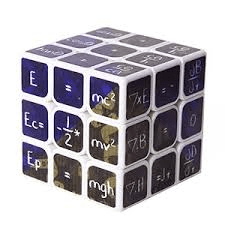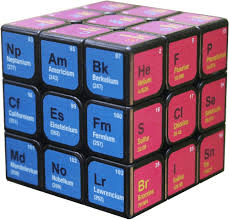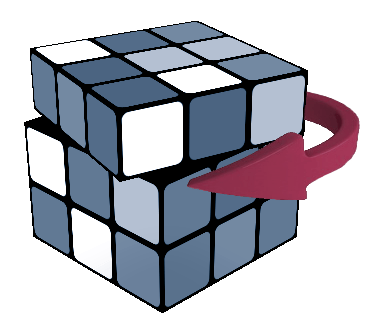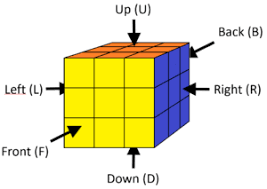Algorithms: Use steps and sequencing to solve problems. Standard - movement clockwise Graphs-show you information as a visual image or picture Orientation- the positioning or overall layout of an item related to other items Patterns: Find similarities and trends. Solving Mosaics Order 1) center 2) edge 3) corner Core - Internal mechanism at center of cube Computational Thinking-4 strategies algorithms decomposition abstraction patterns opposite colors- Yellow/White Green/Blue Red/Orange Mosaic- a picture made by arranging together small colored pieces Edges - Pieces with 2 colors Notation U for Up D for Down L for Left R for Right F for Front B for Back array - a visual representation of objects, pictures, or numbers arranged in rows and columns Piece - 26 make up a 3x3 Rubik’s cube Ernő Rubik- Hungarian Educator and Inventor God's number- 20 moves Center piece - Piece centered both horizontally and vertically on each face Corners - Pieces with 3 colors Inverted - movement counterclockwise Face - Any one side of the cube Pixels- small dots or squares that make up an image Decomposition: Break things down into smaller manageable parts. Ordered pair- can be used to show the position on a graph (x,y) Minus Yellow - if you add or extract yellow from any side you get its opposite Abstraction: Look at relevant and important details only. Algorithms: Use steps and sequencing to solve problems. Standard - movement clockwise Graphs-show you information as a visual image or picture Orientation- the positioning or overall layout of an item related to other items Patterns: Find similarities and trends. Solving Mosaics Order 1) center 2) edge 3) corner Core - Internal mechanism at center of cube Computational Thinking-4 strategies algorithms decomposition abstraction patterns opposite colors- Yellow/White Green/Blue Red/Orange Mosaic- a picture made by arranging together small colored pieces Edges - Pieces with 2 colors Notation U for Up D for Down L for Left R for Right F for Front B for Back array - a visual representation of objects, pictures, or numbers arranged in rows and columns Piece - 26 make up a 3x3 Rubik’s cube Ernő Rubik- Hungarian Educator and Inventor God's number- 20 moves Center piece - Piece centered both horizontally and vertically on each face Corners - Pieces with 3 colors Inverted - movement counterclockwise Face - Any one side of the cube Pixels- small dots or squares that make up an image Decomposition: Break things down into smaller manageable parts. Ordered pair- can be used to show the position on a graph (x,y) Minus Yellow - if you add or extract yellow from any side you get its opposite Abstraction: Look at relevant and important details only.
(Print)
Algorithms: Use steps and sequencing to solve problems.
Standard - movement clockwise
Graphs-show you information as a visual image or picture
Orientation- the positioning or overall layout of an item related to other items
Patterns: Find similarities and trends.
Solving Mosaics Order
1) center
2) edge
3) corner
Core - Internal mechanism at center of cube
Computational Thinking-4 strategies
algorithms decomposition
abstraction
patterns
opposite colors-
Yellow/White
Green/Blue
Red/Orange
Mosaic-
a picture made
by arranging together small colored pieces
Edges - Pieces with 2 colors
Notation
U for Up
D for Down
L for Left
R for Right
F for Front
B for Back
array - a visual representation of objects, pictures, or numbers arranged in rows and columns
Piece - 26 make up a 3x3 Rubik’s cube
Ernő Rubik-Hungarian Educator and Inventor
God's number-
20 moves
Center piece - Piece centered both
horizontally and vertically on each face
Corners - Pieces with 3 colors
Inverted - movement counterclockwise
Face - Any one side of the cube
Pixels- small dots or squares that make up an image
Decomposition: Break things down into smaller manageable parts.
Ordered pair- can be used to show the position on a graph (x,y)
Minus Yellow - if you add or extract yellow from any side you get its opposite
Abstraction: Look at relevant and important details only.





